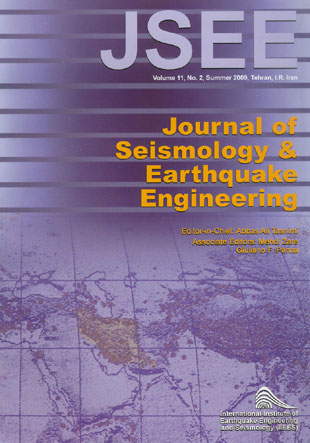فهرست مطالب

Journal of Seismology and Earthquake Engineering
Volume:11 Issue: 2, Summer 2009
- تاریخ انتشار: 1388/05/11
- تعداد عناوین: 5
-
-
Page 55In this paper it will be investigated that whether it is possible to find some regions in which earthquakes occur as well-behaved random processes (instead of chaotic processes). If so, it will be possible to use analysis methods of random processes in earthquake forecasting. There are two main approaches for earthquake prediction; first, precursory methods based on relationship between abnormal behavior of some geophysical quantity (such as gravitational field, crust conductivity,…) and earthquake occurrence. Second, forecasting methods based on the statistical analysis of earthquakes themselves, which is dealt with in this paper. Each probability distribution function (pdf) in statistics has its own coefficient of variations (CV) which due to it we can have a sense of dispersion and variance level of quantity which obeys that specific pdf and also its future variances. In the case of earthquake occurrence also it is possible to calculate the CV of inter-occurrence times of sequential earthquakes in a specified region and specified time interval, in order to find appropriate subregions in which random processes analysis tools can be used for forecasting future seismic behaviors. Here this idea has been applied to Iran.
-
Page 63Recently, many geoscientists have focused on chaos and its relevant subjects for understanding nonlinearity of nature as the main criteria in explaining the dynamic behavior of earthquakes, mineralization and other similar processes. Mathematically, the multivariate iterative functions have basic fractal expression in the analytical, practical and computational domains. In this research, a dynamic model of geophysical precursors is presented, using logistic map, to describe simply the complexities at the edge of chaos. In the proposed model, the seismic, magnetic, gravimetric and electromagnetic data are included. Here, the research region is divided into stable and active areas, according to the historical earthquakes. In this regard, in the Eastern Azerbaijan province around Anatolian fault system, the μ parameter values are used as the average net reproductive rate values. The results show evidential themes containing independent variables in eighteen integrated model cells. Also fourteen forecast cells can be determined after applying the net values into the regions of lower priorities, with or without potential for future events, in comparison with model cells.
-
Page 71In this paper the dynamic response of the ground surface subjected to vertically traveling two dimensional harmonic SH waves in the presence of a single or two canyons is investigated using boundary element method. The models consist of one and two semicircular canyons cut from a homogeneous, linear and viscoelastic half space. The total response is computed by summing up the responses of free field and scattered waves. The former is calculated from the closed form solution of propagated waves in the half space and the latter from the boundary element method. For this, surface irregularities are discretized by linear elements and influence coefficient matrices are obtained by using harmonic fundamental solutions. To validate the technique, the response of a single canyon and its nearby ground surface due to harmonic SH waves with different frequencies is determined and compared with the existing closed form solution. Then, the response of double canyon is determined by the same procedure. Results of analyses indicate that the distance between canyons is a key parameter that affects the surface displacement amplitude of both canyons. It is demonstrated that when this distance is increased, the response of both canyons approach to that of a single one. Furthermore, it is shown that the interaction is also very much dependent on the frequency of the incident wave.
-
Page 83This study proposes a new formulation for modeling soil-structure interaction (SSI) problems. In this direct time-domain method, the half-space soil medium is modeled by spectral element method (SEM) which is based upon a conforming mesh of two-dimensional quadrilaterals, and the structural frame components are modeled by finite element method (FEM). Formulation and various computational aspects of the proposed hybrid approach are thoroughly discussed. To the authors'' knowledge, this is the first study of a hybrid SE/FE method for SSI analyses. The accuracy and efficiency of the method is discussed by developing a two-dimensional SSI analysis program and comparing results obtained from the proposed hybrid SE/FE method with those reported in the literature. For this purpose, a number of soil-structure interaction and wave propagation problems, subjected to variousexternally applied transient loadings or seismic wave excitations, are presented using the proposed approach. Each problem is successfully modeled using a small number of degrees of freedom in comparison with other numerical methods. The present results agree very well with the analytical solutions as well the results from other numerical methods.
-
Page 97Fuzzy control has recently been proposed to control the properties of magnetorheological (MR) dampers and therefore reduce vibrations of civil structures subjected to earthquake loads. These controllers have the advantage of not depending on system model, of being simple, and intrinsically robust. Their tuning, however, has shown to be a difficult task. This paper proposes a gain-scheduled fuzzy controller to regulate the damping properties of MR dampers and reduce structural responses of single degree-of-freedom seismically excited structures. Robustness of the algorithm to changes in seismic motions and structural characteristics were assessed by subjecting two different one-story buildings, one rigid and one flexible, to a wide range of earthquake records. Results show that the algorithm proposed effectively reduced responses of both structures to all twenty-four earthquake motions considered. In addition, results were compared to those of a fuzzy controller with constant scaling factors and to those of two passive systems: "passive on" and "passive off", where the current to the MR damper was set at maximum allowable value, and zero, respectively.


